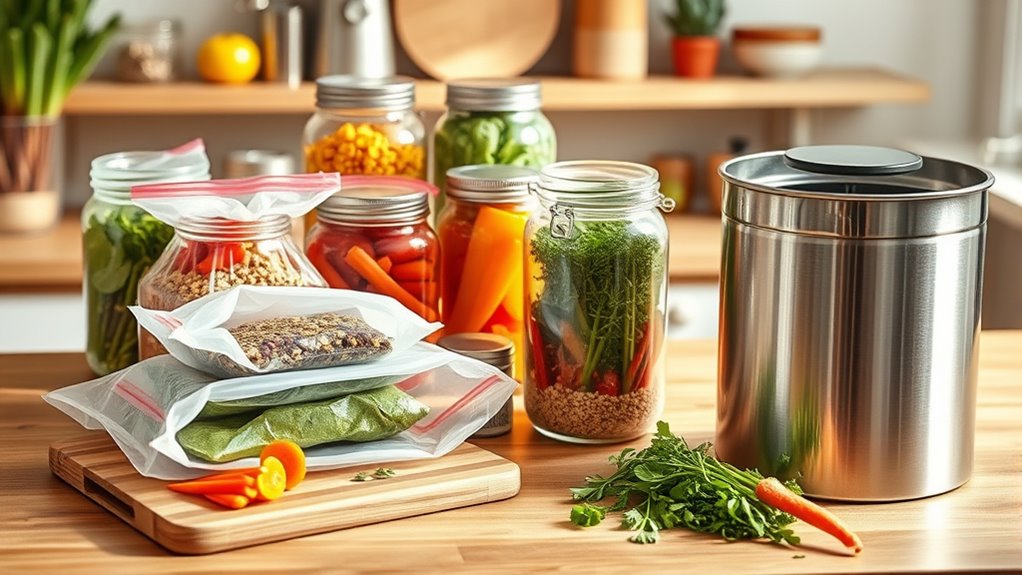To start zero-waste meal prep as a beginner, focus on planning with inventory checks, batch-cooking perishables, and storing food in reusable containers. Shop locally, buy in bulk, and choose minimal packaging to reduce waste. Get creative by using food scraps for stocks or pestos, and incorporate composting. Essential tools include glass containers and beeswax wraps. Consistently practicing these habits and building a community will help you stay on track—there’s much more to uncover to make sustainable meals simple and fun.
Key Takeaways
- Plan meals around perishable ingredients, batch-cook, and store leftovers in reusable containers to reduce waste.
- Shop with reusable bags, containers, and buy in bulk to minimize packaging waste.
- Use food scraps like vegetable trimmings for stocks, pestos, or compost to divert waste from landfills.
- Properly store food and leftovers to extend freshness and prevent spoilage.
- Engage with community programs and educational resources to stay motivated and improve waste reduction practices.
Embracing the Principles of Zero-Waste Meal Planning
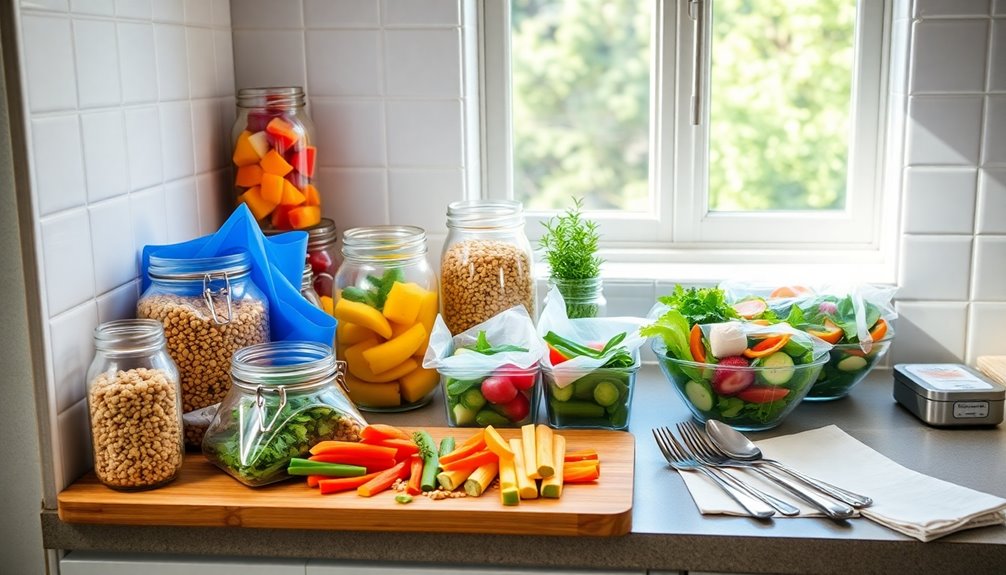
Embracing the principles of zero-waste meal planning starts with mindful inventory management. You should conduct weekly checks of perishables to spot items that need immediate use, prioritizing older ingredients to prevent spoilage. Creating a visual food list with highlighted grocery items helps streamline shopping and avoid redundant purchases. Designate specific prep days to batch-cook perishables before they expire, and use a topical menu planner—like grouping meals into “soups” or “salads”—to maximize ingredient flexibility. This approach keeps your kitchen organized, reduces waste, and encourages smarter resource use. Implementing proper food storage techniques can further extend the freshness of your ingredients and reduce spoilage. Staying attentive to inventory guarantees you use what you have efficiently, minimizing excess and spoilage. Incorporating inventory management strategies can also help you better plan your shopping trips and meal prep routines. Utilizing sustainable practices such as composting scraps can significantly reduce overall waste. It’s a simple but powerful way to embed sustainability into your meal routines from the start.
Smart Shopping for a Sustainable Kitchen
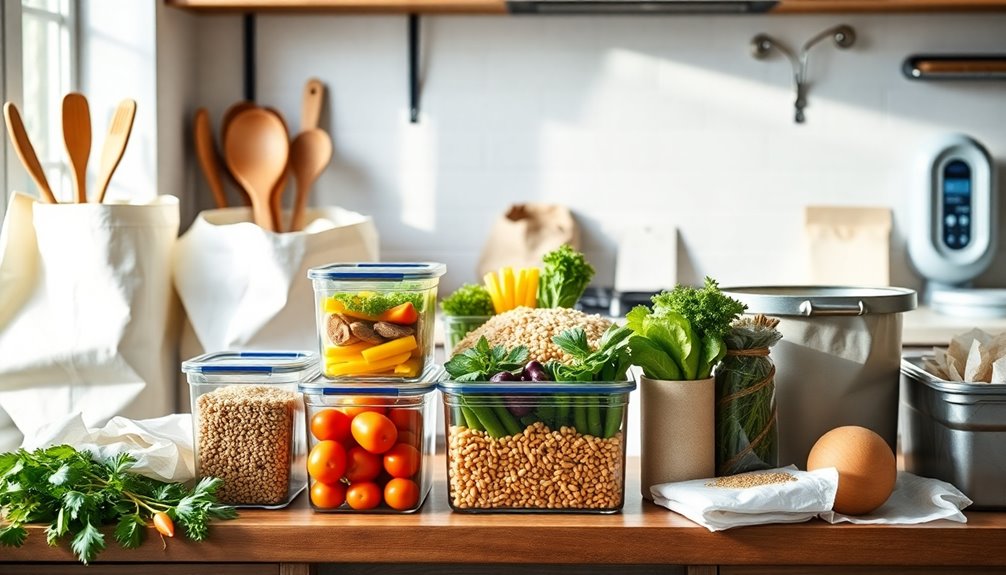
Smart shopping plays a key role in maintaining a sustainable kitchen and reducing overall waste. Focus on buying whole, unprocessed foods to cut packaging waste and avoid artificial additives. Opt for bulk purchases to minimize plastic and other packaging, and bring reusable bags and containers to stores to eliminate single-use plastic. Support local farmers markets and zero-waste stores, which offer fresh, minimally packaged produce and goods. Choose products with less packaging or those sold in reusable containers. Avoid processed foods, which tend to have excessive packaging and shorter shelf lives, leading to more waste. Incorporating reusable containers can add a personal touch to your lifestyle, reflecting your personality and preferences. Being aware of packaging waste and selecting products with sustainable packaging options can further enhance your efforts. Additionally, paying attention to the environmental impact of your purchases can guide you toward more eco-friendly choices. Research shows that zero-waste shopping significantly reduces overall household waste and supports sustainable living. Smart shopping sets the foundation for sustainable, zero-waste meal prep.
Creative Ways to Use Food Scraps and Leftovers
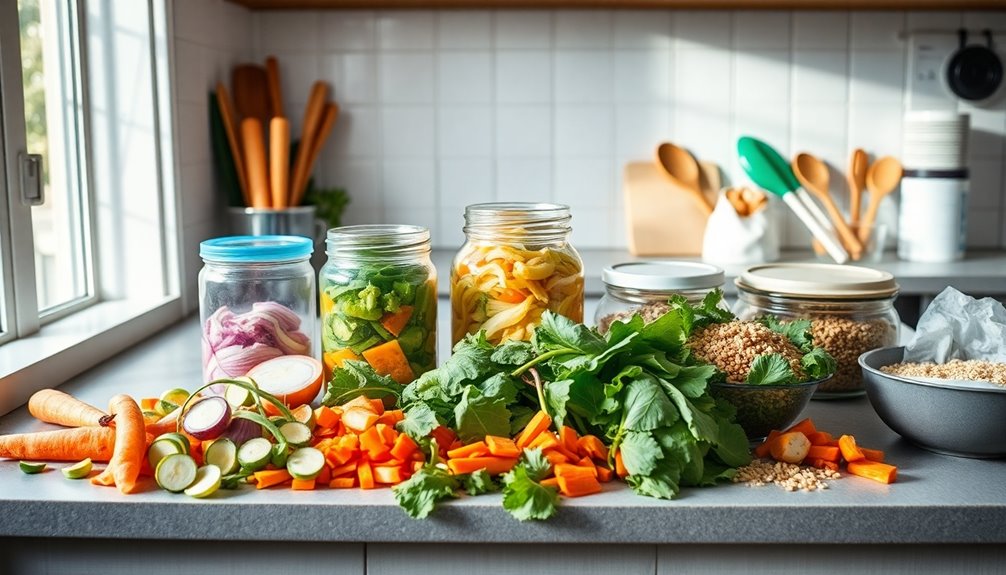
Finding creative ways to use food scraps and leftovers not only prevents waste but also adds flavor and variety to your meals. Vegetable trimmings like carrot tops, radish greens, and celery leaves can be blended with nuts and garlic to make tasty pestos, reducing waste and enhancing dishes. Citrus peels add aroma and can freshen garbage disposals or infuse water for cleaning. Apple peels and cores simmered in water create flavorful teas or help clean cookware naturally. Stale berries, peels, and tops can be cooked into jams, while vegetable scraps simmered make nutrient-rich stocks. Incorporating waste minimization techniques like these significantly contributes to a more sustainable kitchen. Additionally, choosing appropriate storage methods ensures that leftovers stay fresh longer, reducing the likelihood of waste. Proper food preservation methods help extend the usability of leftovers and scraps, further reducing waste. Using food scraps this way minimizes waste and sparks culinary creativity in your kitchen. Incorporating a personality trait assessment can help you identify your strengths and preferences, making meal planning and waste reduction efforts more aligned with your personal style. Exploring candle-related techniques, such as repurposing wax or making wickless candles, can also inspire creative uses for leftover wax and reduce waste.
Essential Tools for Eco-Friendly Meal Prep
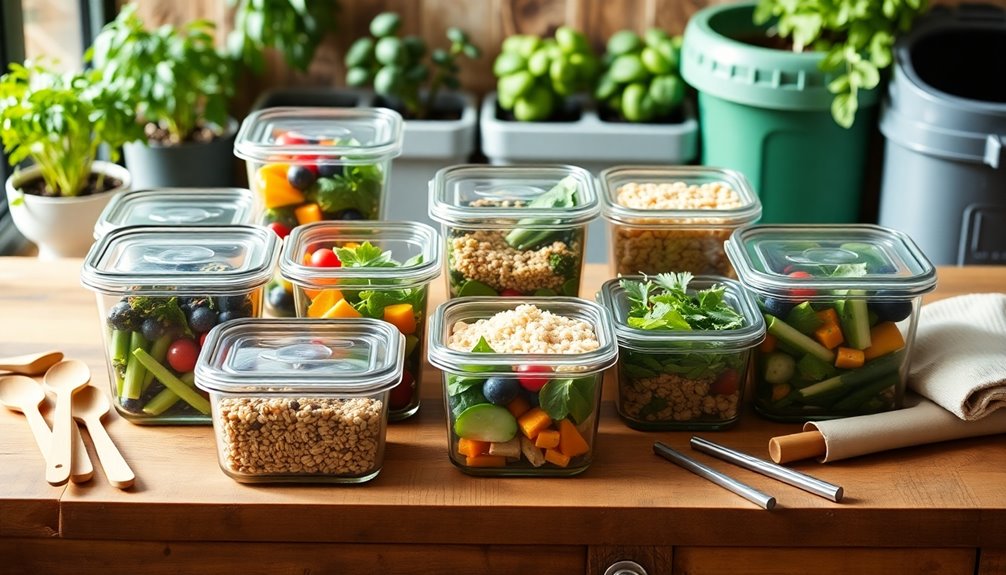
To make your meal prep more eco-friendly, choosing the right tools is essential. Reusable storage containers like Rubbermaid’s Brilliance, available in glass or plastic, keep your food fresh while reducing waste. Silicone bags, such as Stasher, are great alternatives to disposable plastic, perfect for freezing and heating. Glass jars are durable and non-toxic, ideal for storing dry goods and leftovers. Compostable containers made from sustainable materials help cut down on single-use plastics. Vacuum-sealed containers preserve freshness longer, minimizing waste. Additionally, beeswax wraps and reusable snack bags made from natural or sustainable materials eliminate plastic wrap and bag waste. Mason jars and compostable wraps are versatile options for on-the-go meals. Investing in these eco-friendly tools makes your meal prep more sustainable and waste-free. Incorporating low carb foods into your meal prep can also help you maintain a healthy, sustainable diet. Using reusable kitchen tools can further reduce your environmental impact and support a zero-waste lifestyle. Moreover, choosing tools made from sustainable materials aligns with eco-friendly principles and reduces overall environmental footprint. Selecting energy-efficient appliances for preparation and storage can also contribute to a greener kitchen.
Simple Techniques to Get Started With Batch Cooking
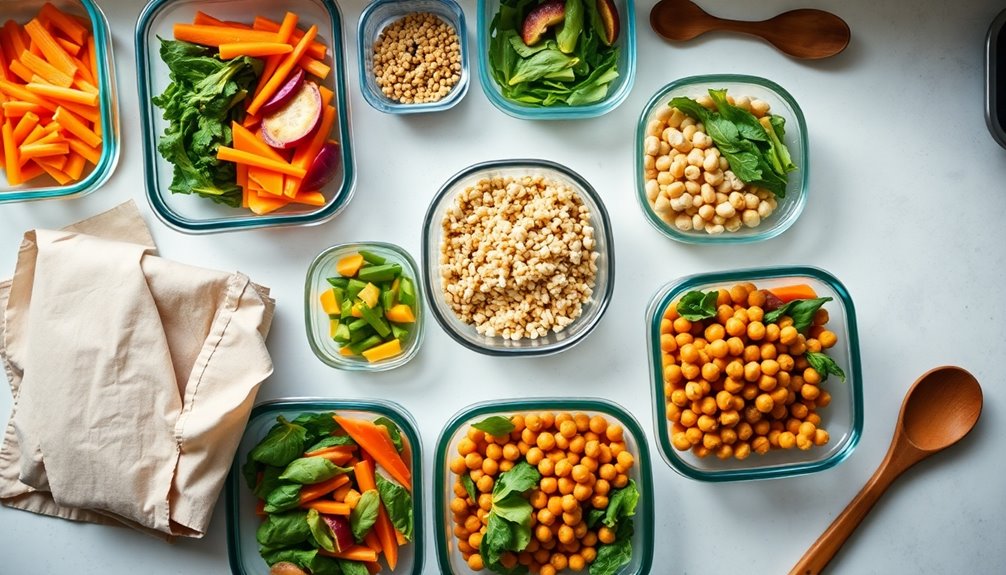
Starting with a few simple techniques can make batch cooking approachable even for beginners. Begin by preparing base ingredients like rice, quinoa, or lentils in advance; this speeds up meal assembly and reduces waste. Use a meal plan or calendar to organize your cooking schedule and avoid unnecessary leftovers. Cook large batches of ingredients during less busy times, utilizing efficient methods like baking or slow cooking to multitask. Store meals in reusable containers, labeling and dating them to track freshness. Freeze portions to extend shelf life and minimize waste. Organize your freezer for easy access, and keep a record of successful recipes for future repetition. These strategies help you start batch cooking with confidence while practicing zero-waste principles.
Tips for Maintaining Consistent Zero-Waste Habits
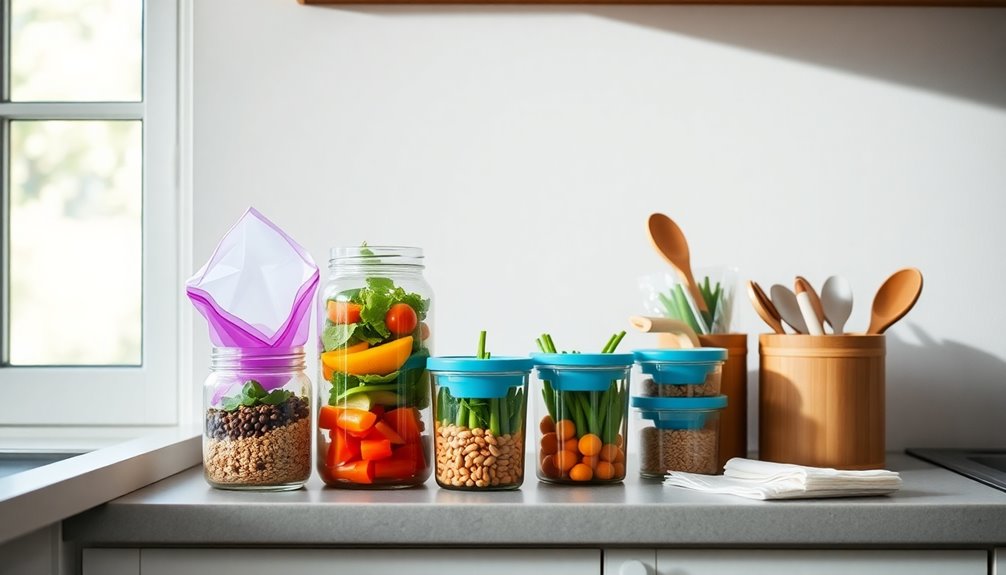
Maintaining consistent zero-waste habits requires deliberate effort and ongoing commitment. To stay on track, plan your meals ahead of time, creating detailed shopping lists to prevent impulse buys. Focus on sourcing ingredients with minimal or biodegradable packaging, and buy in bulk when possible. Practice portion control to reduce leftovers and waste, and store prepped meals in reusable containers. Choose seasonal, local produce to lower your carbon footprint and avoid overbuying. Incorporate food scraps into composting to minimize waste. Use energy-efficient cooking methods and water-saving techniques. Reuse utensils and glass containers, and refuse unnecessary packaging. Continuously educate yourself about new practices, monitor your progress, and adjust habits as needed. Engaging with zero-waste communities can provide ongoing support and fresh ideas. Being mindful of food storage techniques can also help extend the freshness of ingredients and reduce spoilage. Developing a sustainable shopping mindset further enhances your commitment to zero-waste living and reduces environmental impact. Embracing a creative practice can inspire innovative ways to minimize waste and optimize resourcefulness in your kitchen. Proper food preservation methods can further minimize waste and enhance sustainability.
Building a Community to Support Your Zero-Waste Journey

Building a community that supports your zero-waste journey involves more than individual effort; it requires coordinated action and shared commitment. Developing a formal Zero Waste Strategic Plan helps create system-wide change and shifts community culture. Engaging stakeholders through participatory approaches ensures your community’s values and resources align with zero-waste goals. Regularly reassessing the plan maintains momentum and adapts to new challenges. Set clear targets for waste reduction, diversion, and circular resource use, and implement universal recycling and composting services to ensure consistent waste management practices citywide. Policy measures, like mandatory source separation and bans on landfilling certain materials, reinforce community efforts. Investing in infrastructure such as recovery facilities and community composting centers, along with ongoing education, empowers residents and businesses to participate actively in your zero-waste journey. Incorporating a growth mindset among community members can foster innovative solutions and sustained engagement in waste reduction initiatives. Additionally, collaborating with local breakfast delivery providers to promote sustainable packaging options can further reduce waste and support your community’s zero-waste objectives.
Frequently Asked Questions
How Do I Start Transitioning to Zero-Waste Meal Prep Gradually?
To shift gradually, start by setting simple goals like bringing reusable bags and containers. Focus on planning your meals with overlapping ingredients, which reduces waste. Incorporate bulk buying and seasonal produce, and find ways to repurpose leftovers. Slowly replace disposable wraps with reusable ones and freeze meals in advance. By making small, consistent changes, you’ll build sustainable habits over time without feeling overwhelmed.
What Are Some Common Challenges Faced When Reducing Food Waste?
Tackling food waste feels like fighting a giant with a tiny sword—overwhelming but possible. You face huge challenges like poor infrastructure that blocks food from reaching your plate, confusing date labels causing unnecessary disposal, and supermarkets rejecting imperfect produce. Plus, limited storage and inefficient supply chains lead to spoilage. But with awareness, smarter planning, and small changes, you can make a big impact and fight this colossal waste.
How Can I Store Leftovers to Maximize Freshness and Reduce Spoilage?
To maximize freshness and reduce spoilage, you should store leftovers in airtight containers, like BPA-free plastics or glass, and label them with dates. Cool hot foods before refrigerating, keep your fridge at or below 40°F, and store fruits separately to prevent spoilage. Portion leftovers to avoid repeated opening, use sustainable storage options, and consume older items first. Regularly check your stored food, ensuring nothing goes to waste.
Are There Affordable Options for Eco-Friendly Meal Prep Containers?
Think of eco-friendly containers as your green sidekick in meal prep. You can find affordable options like biodegradable containers made from sugarcane fiber or wheat straw, which are certified compostable and great for hot or cold foods. Reusable BPA-free bentgo containers and stainless steel options from brands like U Konserve also offer cost-effective, durable choices. These eco-friendly containers help you save money while reducing your environmental footprint.
How Do I Adapt Zero-Waste Principles When Dining Out or Ordering Takeout?
When dining out or ordering takeout, you can adapt zero-waste principles by bringing your own reusable containers and bags. Talk to staff about your preferences, asking for no single-use items and minimal packaging. Choose restaurants that prioritize sustainability, like farm-to-table or those with zero-waste certifications. Communicate your needs clearly online or in person, and support places that compost leftovers. This way, you reduce waste and stay eco-friendly.
Conclusion
Now that you’re ready to explore zero-waste meal prep, imagine the impact of every mindful choice you make. Each scrap reused, each meal planned thoughtfully, brings you closer to a sustainable routine. But the real change begins when you decide to stay committed, even when challenges arise. Will you open the full potential of your eco-friendly kitchen? Your journey has just begun—what’s next could transform not just your habits, but the world around you.
